Amaryllis belladonna
| Botanical Name | Amaryllis belladonna |
|||||||||||
| Family | Amaryllidaceae - The amaryllis family. |
|||||||||||
| Pronunciation | am-uh-RIL-us bel-la-DON-na |
|||||||||||
| Common Name(s) |
English: Belladonna Lily; March Lily; Naked Lady
Afrikaans: Amaryllis; Belladonnalelie; Maartlelie; Misblom; Misrybol; Misryersblom
|
|||||||||||
| Plant Group |
|
|||||||||||
| Plant Size |
|
|||||||||||
| Position |
|
|||||||||||
| General Information |
|
|||||||||||
| Specific Information | Amaryllis belladonna is a bulbous plant with strap-like leaves about 50 cm long and a large, rounded brown bulb. Flowering takes place in February or March before the leaves appear, hence the common name Naked Lady. The leaves appear after flowering and grow throughout the wet winter months, but die back in summer when the bulb becomes dormant. In this way, the plant conserves its resources by avoiding stress during the hot dry period of its Mediterranean-type climate. The late flowering time allows the short-lived seed to fall just before the cooler rainy season. The bulb will survive heat but sustained winter temperatures of -5°C and below will result in the death of the plant. In cultivation flowers are produced almost every year but in their natural fynbos habitat they emerge in great numbers only after fire. The bulbs are very toxic to livestock and humans. |
|||||||||||
| Ad Break | ||||||||||||
| Flowers | ||||||||||||
| Description | up to twelve trumpet-shaped flowers on a 50 cm tall purplish-red and green stem |
|||||||||||
| Season |
|
|||||||||||
| Colour |
|
|||||||||||
| Growth Rate |
|
|||||||||||
| Plant Uses |
|
|||||||||||
| Distribution and Habitat | in the south-western part of the Western Cape in small dense groups among rocks |
|||||||||||
| Planting Suggestions | Amaryllis belladonna is not difficult to grow and needs little attention. Plant the bulbs in a sunny or slightly shaded position in well-drained soil. The bulbs should be planted with their necks just above the ground. Do not remove the old leaves until they are completely dead. Mature bulbs will provide offsets which can be removed and replanted and the seed germinates well if sown fresh. It will take 4 - 6 years for plants to flower from seed. Division of clumps is done in late spring or summer. The plants resent interference and may not flower the first summer after replanting. For those in cold climates, Amaryllis should be grown in pots. Use a free-draining mix of equal amounts of sharp sand, compost and loam, and plant the bulbs 5 - 6 cm away from the pot wall. Amaryllis belladonna is often attacked by the destructive black and yellow striped Lily Borer caterpillar. |
|||||||||||
| Medicinal Uses | The sap from the bulbs was reportedly used by the Khoi and San people as an arrow poison. |
|||||||||||
| Ad Break | ||||||||||||


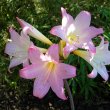
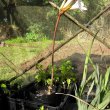
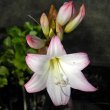
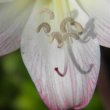

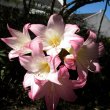
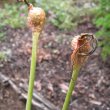


Comments
Looking for stems for a wedding
Hi there,
This may be a strange request but does anyone know who sells amaryllis stems. I have enough time to grow a garden-full, but so scared about quality (and my eager puppy!!!)
I'm looking for loads of them for our wedding in April. Please help
Flowering stems of amaryllis
Hi Caryn
I have personally never seen Amaryllis belladonna stems on sale. This could be because the blooms themselves are a bit delicate and bruise quite easily, even when gently handled, so they are not commercially viable as cut flowers. Also,the flowering period is limited to a couple of weeks a year and even then, the flowering time varies according to the weather and rainfall.
The only place I can imagine you might get them would be flower sellers in Cape Town, so if that is where you live, you may get lucky. You would have to contact the flower wholesalers there.
Best wishes for your special day.
Kind regards
Lorraine
Thanks Lorraine. I'm in
Thanks Lorraine. I'm in Johannesburg.
Thanks for explaining.
I have seen a few at our local florist, but, as they're so delicate, with all the other reasons you mention it might be difficult to count on it.
Warm Regards,
Caryn
Wedding flowers
Hi Caryn
Have you ever been to the flower wholesalers at Kazerne? I loved that place - flowers everywhere at much less than you would pay at florists. Also one can talk to the dealers about what will be available. If nothing else, it is a fun outing. Also have a shop that stocks lots of wedding stuff.
Warm regards
Lorraine
Discuss this plant
Share knowledge, ask a question or give an experience.